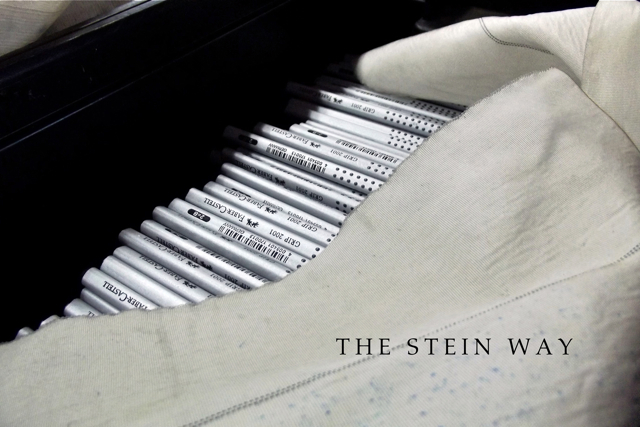
About a month ago, I received an extraordinary invitation: Faber-Castell wanted to know if I would like to come visit their headquarters in Stein for a few days, to have a tour of the castle and production facilities, and to meet with Count Anton-Wolfgang von Faber-Castell.
Yes. I would like that very much.
I would be taking part in their International Media Days event, where I would join a handful of professional journalists from Turkey, France, and Germany in Stein bei Nürnberg—Die Bleistiftstadt. The itinerary was organized up to the minute with presentations, tours, and interviews, but there was one other thing that I wanted to ask about. Faber-Castell had already been so generous that I was reluctant to pile-on a favor, but to go that far and to come so close to possibly finding the answers to questions I’ve had for years meant I was willing to risk a faux pas: “Would it be possible for me to spend some time in your archive?”
Since the Faber-Castell archive isn’t open to the general public (and wasn’t a scheduled stop on the itinerary) I was prepared for the possibility that my request might be declined. But without hesitation Sandra Suppa, Head of Corporate Communications, arranged for me an hour-long meeting with an archivist the morning I was to arrive in Stein. In an attempt to make things more manageable for everyone involved I sent ahead a narrowed request to look at product catalogs from ca. 1900 to 1950, in particular, those of Eberhard Faber in the U.S. and Germany.

After 14 hours and a short taxi ride from the airport in Nürnberg I arrived at Faber-Castell headquarters around 9:30 A.M., where I met with Sandra, Antje Röder (Head of Product and Marketing Communications), and Stephanie Birch.
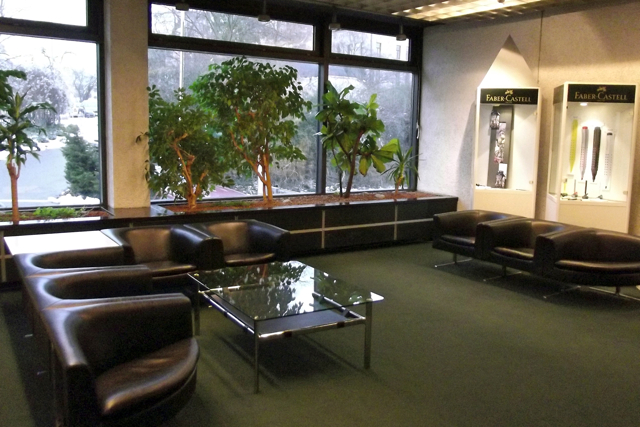
After visiting for about an hour I was escorted over to the castle, which is a short walk from the corporate offices.

The Archive
Upon arriving I was introduced to archivists Edith Luther and Correlia Börner, and the materials I had requested a few days earlier were placed neatly on two tables. I was politely asked to refrain from taking pictures in the archive, so you’ll just have to use your imagination: it isn’t one large repository, but rather several small rooms complete with filing cabinets, archival boxes, and creaky wooden floors. Around every corner there were either large, vintage posters, drawers full of pencils, or decades-old counter displays. It was easy to be distracted, but with only an hour to spend I set about poring over the pulled materials.

I was told several times that the archive contained very little in terms of Eberhard Faber catalogs from the U.S., but it became immediately apparent that the word “little” here was a relative term—there were four boxes full of product catalogs and pricelists dating back to 1901. Up until this point, just finding several consecutive pages of similar materials was like spotting a four-leaf clover. Here, it was like sitting in a forest of them.
There was everything from small, pocket catalogs, to full size (and in some cases full-color) catalogs. Things I’ve spent countless hours looking for only to find a poorly-scanned advertisement or two (such as the extender with the clamp eraser), could now be found on page after page after page of beautiful, hand-illustrated originals. Of course, I could have happily spent the next six months in Stein reading every last piece of paper in the Faber-Castell archive, but it was time to go.
This one hour alone would have made the trip worthwhile many times over, but there was much more to come.
Part 2: Das Schloss
 The old lead factory across the river.
The old lead factory across the river.
Here’s a sentence that I don’t get to use very often: My day began at 9:30 a.m. on the ground floor of the castle.

Many of the photos I took inside the castle didn’t turn out very well, so for a better room-by-room view click this link for a virtual tour. There were many obvious things you’d expect to appreciate about the Faber-Castell castle, but added to my list was experiencing what living in an M.C. Escher print might be like:

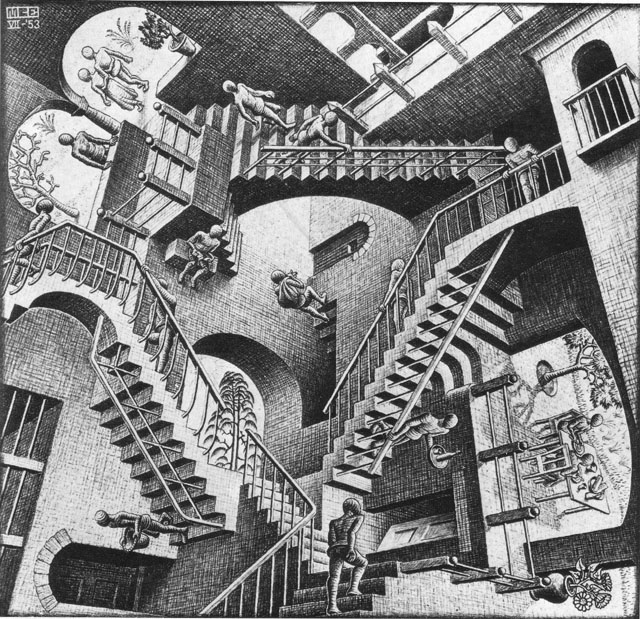
The second floor featured a nice display of historical and noteworthy items, including the ornate chest that Lothar Faber created for exhibiting his products to potential buyers abroad. The exhibits were under glass, and the lighting was low, but this should give you an idea:


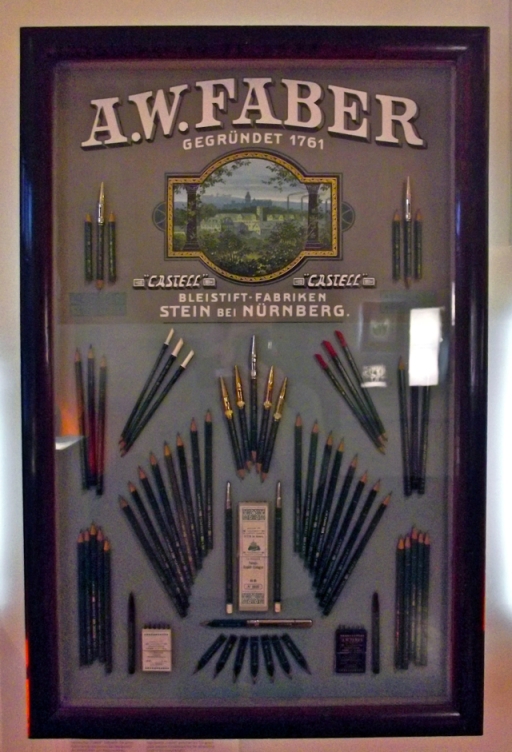
There were several presentations planned, including a portrait of Faber-Castell and discussions about their environmental efforts, sustainability, and social charter (you can see a video about sustainability here, and can read the 2011 report here).
It was interesting to learn that 80% of Faber-Castell products are produced outside of Germany, and for that reason they no longer consider themselves only “…a German company.” And of the 15 factories they have worldwide only 3 of them are making pencils: Germany, Indonesia, and Brazil (the Art and Graphic products as well as the premium products are made exclusively in Germany). Together, those 3 factories produce some 2.4 billion pencils per year.
Production Facilities
The main factory is about a 5-minute walk from the castle, and is immense. One thing that struck me was how clean it all was—I had expected since you’re dealing with so much wood, graphite, and lacquer (and in such large proportions) that it would be perfectly normal to have some detritus here and there. Nope, not one bit: I make more of a mess using one pencil than they do making one million of them.
If you’d like to see the pencil-making process from beginning to end, have a look at this video made by Faber-Castell—the following photos don’t depict the complete process.
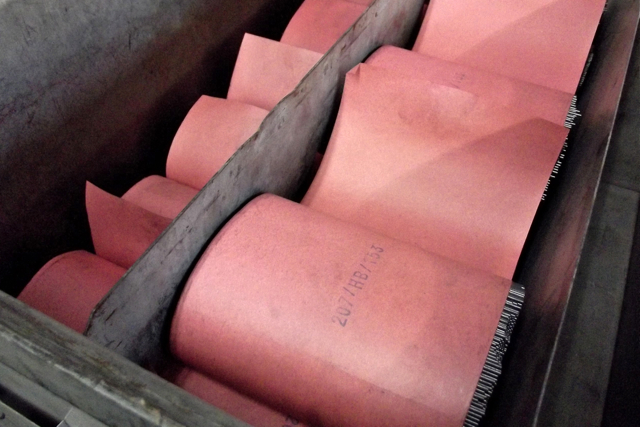 Case after case of leads are sent over from the “old” lead factory.
Case after case of leads are sent over from the “old” lead factory.
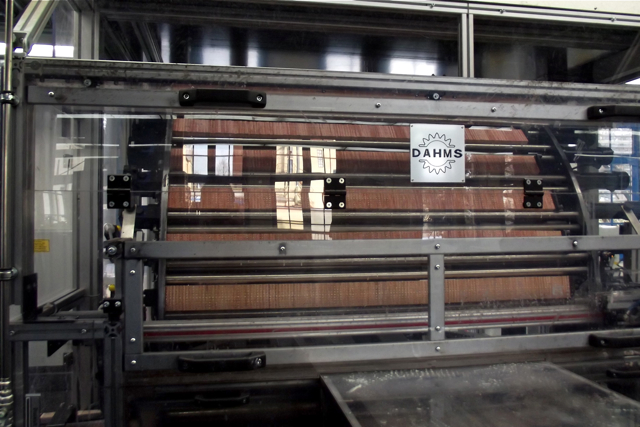 Glued “sandwiches” are compressed and dried.
Glued “sandwiches” are compressed and dried.

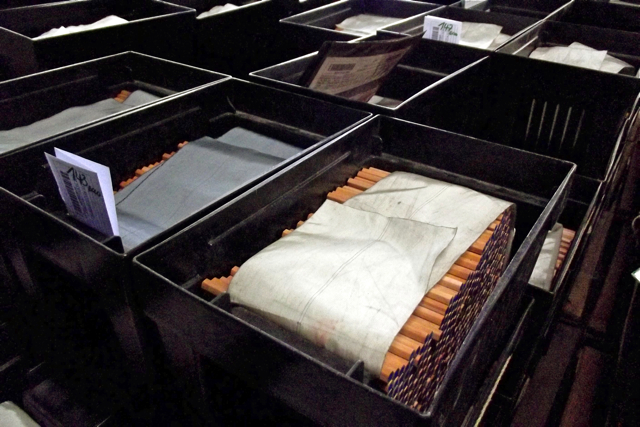 Headed to the lacquering department.
Headed to the lacquering department.
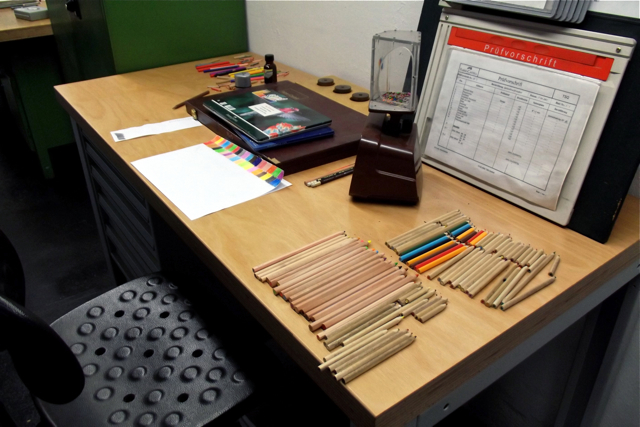
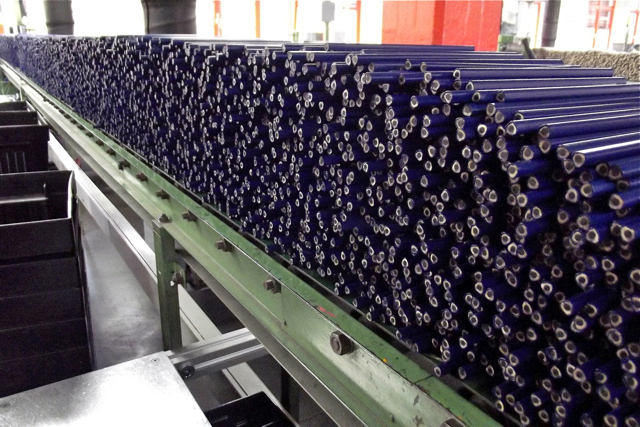
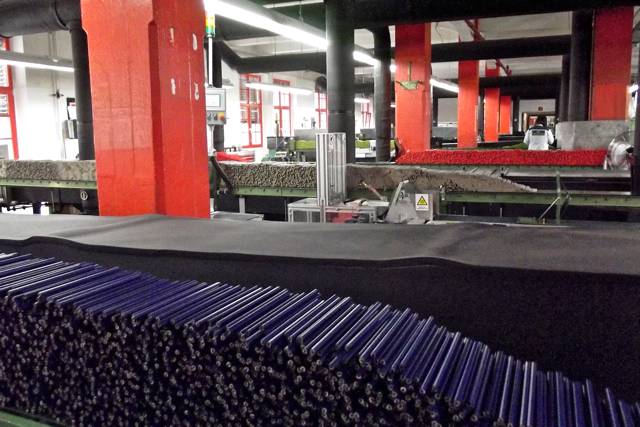
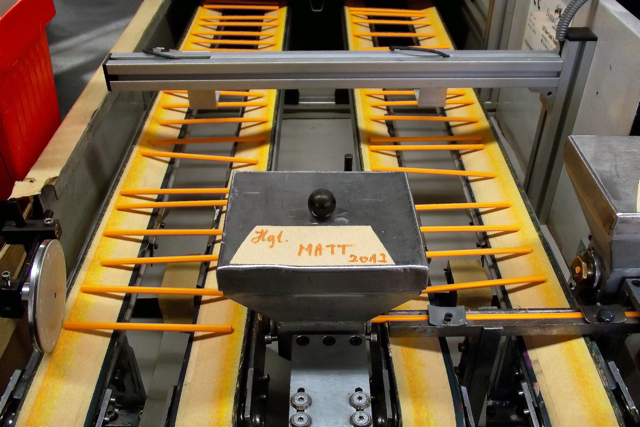
Part 3: Stein, and the old lead factory
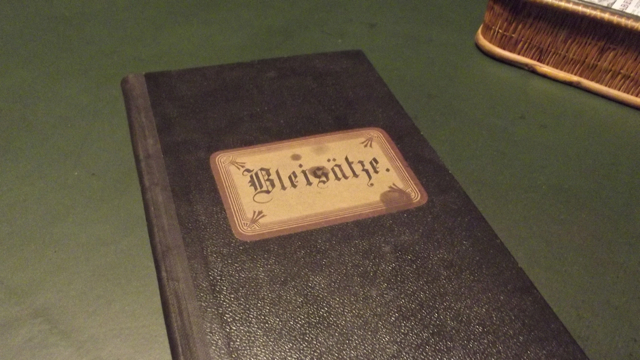
The reason I called this series “The Stein Way”, apart from the pun, had everything to do with experiencing how intimately tied the history of A.W. Faber-Castell is to the city of Stein. Put another way, you can’t separate the company from the city—a point that was made tangibly clear during the brief time I was there. It’s one thing to say that such-and-such is an old town, or that so-and-so erected some buildings, it’s quite another to see it firsthand and to get a palpable sense of the history, effort, and dedication behind it all (or perhaps, underneath it all).
To that end, you might say that each pencil produced at Faber-Castell today took 251 years to make.
Die Bleistiftstadt
Faber-Castell arranged for a walking tour of the city, which was guided by a local historian. Cold weather and a little drizzle notwithstanding, I ended up being the only one of our group who took part in the complete tour. That was fine by me though—more chances to ask questions.

I was told that the origin of Stein’s name (meaning “stone”) likely comes from the stone bridge that once stood across the Rednitz—an explanation in line with the long (and interesting) history of European place-names. Dating back to the 13th century, there is nothing left of it above the waterline but its location was just south of the current bridge:

Apparently, Kaspar Faber (1730-1784) chose Stein because the craft guilds in nearby Nürnberg were imposing an increasing number of regulations and restrictions on new businesses. He sidestepped this problem by setting up shop just outside the city walls.
 Same view, on the opposite bank of the Rednitz (Faber-Castell factory)
Same view, on the opposite bank of the Rednitz (Faber-Castell factory)
Lothar, a 4th-generation Faber (1817-1896), is the man who perhaps had the greatest impact on the company (vis-à-vis expansion and modernization) and the city of Stein, whose population was growing in no small measure due to the influx of factory employees.
Lothar wasn’t just focused on making products, he also went to great lengths to care for his employees: he erected housing for them, established employee savings accounts, and even instituted healthcare plans—something novel in the erstwhile days of industrialization. He was also concerned with educating the children whose parents were working in the factory, so a school was erected. But this wasn’t purely altruistic; he expected and cultivated loyalty from his employees, resulting in some families staying with the company for generations. Faber-Castell’s sense of social responsibility is as strong today as ever—something likely unknown to the average pencil buyer.
 Mecklenburger Platz
Mecklenburger Platz
But just as Lothar Faber was concentrating on the welfare of his employees, he was also making unprecedented strides toward expanding A.W. Faber as well. Most notably he established offices in major cities—London and Paris—but he also had the foresight to open a sales office in New York as well, to be run by his youngest brother, Eberhard. Something that Lothar could not have predicted, however, was how quickly Eberhard (and his other brother, Johann) would establish pencil companies of their own, which would operate in direct competition with A.W. Faber for decades to come.
There is much, much, more to the story of Stein than what I have written here. But from the church, the factories, to the streets bearing the names of Faber family members, it’s plain to see that Stein owes much of its identity (and even its modern existence) to the concerns of the Fabers and the Faber-Castells—something tacitly imbued in all that they make.
Alte Mine Museum
On the other side of the Rednitz is the “Old Lead Factory”, which houses a museum as well as modern production facilities.

The entrance to the museum has a gate, whose posts are made of Castell 9000 pencils:


As you walk down to the basement level you soon realize that you are about one meter below the waterline. It was interesting to learn that to this day they still harness the power of the Rednitz: about 20% of their energy is provided by hydro-electric power. As you might imagine the work area is cold and damp; what I can’t quite imagine though is what it would have been like working there 100 years ago:
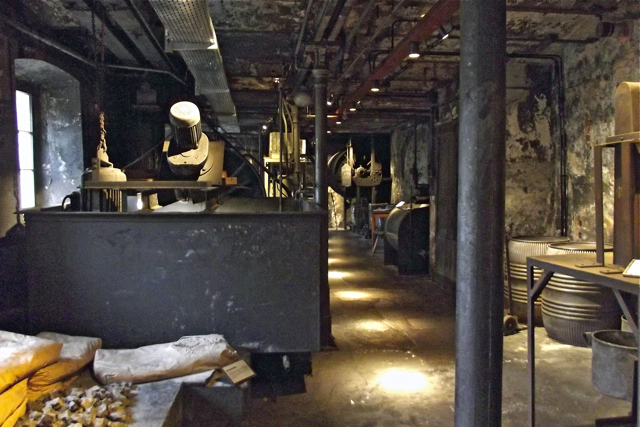
Along the way you can see the steps involved in pulverizing and refining the graphite, mixing it in with clay, and extruding it into long coils that are eventually cut and baked:
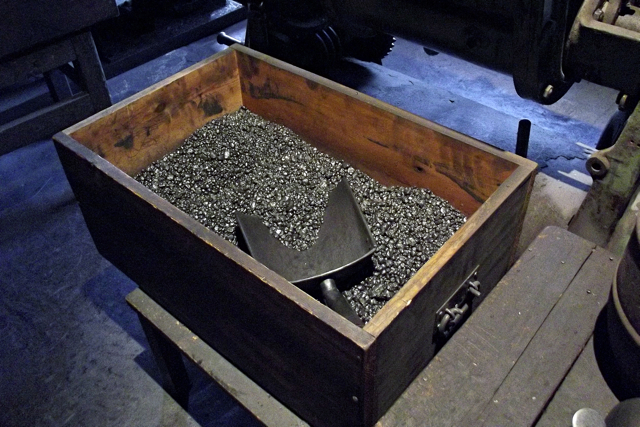


 Some records-keeping from the 1960s
Some records-keeping from the 1960s
Last was the accounting office, set up as it was during the early 20th century:
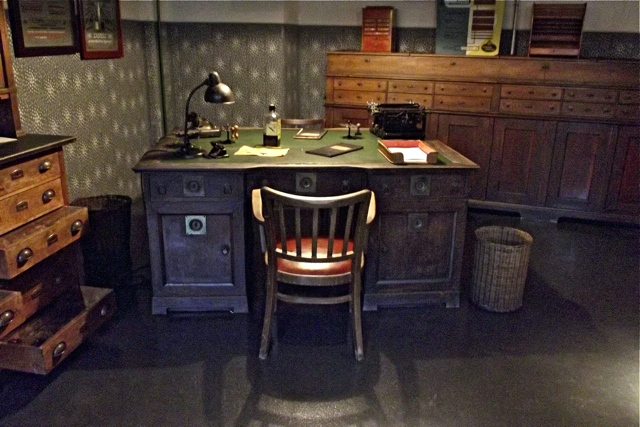

Public tours are available for the castle, the main factory, and the lead factory. But if you have the opportunity to visit Faber-Castell, a tour of Stein (no matter how brief) should be added to your list.
Conversations with the Count
From the time I received Faber-Castell’s invitation, up until and including the second day of the visit, there was something I was a little apprehensive about. Though I was happy to learn that I would have the opportunity to meet with Count Anton-Wolfgang von Faber-Castell, it was going to be in the context of an interview. While there was no shortage of questions I’d like to ask him they weren’t the types of things you’d likely expect in an interview of this sort—unlike the handful of others who were there in a professional capacity, my interests were entirely personal. However, any concerns I may have had were allayed the night before during dinner.
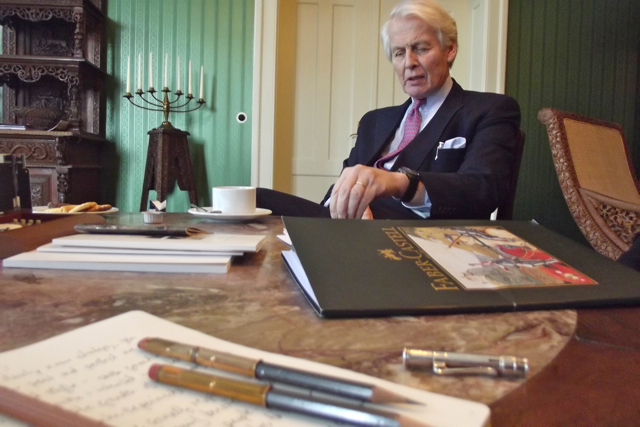 Sitting across from Count Faber-Castell.
Sitting across from Count Faber-Castell.
About 15 people were present for dinner at Sebald in Nürnberg, walking distance from the historic Christkindlmarkt. We were set up in an intimate, upstairs room; a few tables were combined to form one long, rectangular table. Scanning for my name among the place settings I saw that I was going to be sitting next to the Count—this was unexpected, and had me hoping that my jet lag wouldn’t do most of the talking. He arrived soon after, made his way around the table, and greeted each of the journalists and Faber-Castell employees. We shook hands, and were seated.
And for the next few hours, our conversation touched upon just about everything—from Faber history, pencils old and new, to the pleasure of writing things down.
The Next Day
The schedule for the second day was as packed as the first, but it also included interview appointments with the Count. I was scheduled for the last slot of the afternoon, together with a journalist from Turkey. Rather than go round-robin with questions, I suggested that she go first so that she could get everything she needed. The hour started to get away from us but I wasn’t too concerned—I had asked him just about everything I could think of the night before at dinner. So, rather than an interview per se, I thought perhaps we could just pick up from where we left off the night before.

Finished with her interview the Turkish journalist needed to catch her plane, leaving myself, Sandra Suppa, and Count Faber-Castell around a small table in a room on the second floor of the castle.
Packing for this trip I thought I’d bring some select items to share; if nothing else they might be handy as a conversational crutch if I ran out of things to ask about. But then I thought twice—what could I possibly have in my small collection that the Count hasn’t already seen many times over? After all, I would be traveling to the heart of A.W. Faber-Castell, so it wouldn’t be a first to bring these vintage items to the castle—this is where they were made in the first place—if anything, they were coming home. In the end I decided on a few A.W. Faber items, including this Zeichenstift set from ca. 1906. I also brought a few very old copying pencils, which I intended to offer as a donation to the archive, should they like to have them.
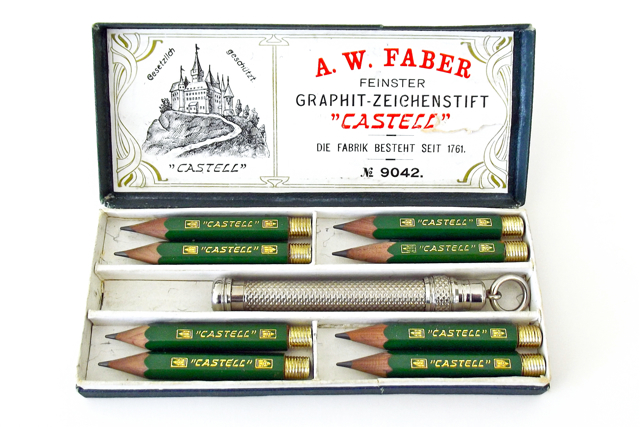
The remaining items included Blackwing pencils, some Faber-Castell issues of Eberhard Faber pencils from 1988-1994, caps, exenders, as well as a selection of vintage Eberhard Faber products including the Van Dyke, Mongol, and Microtomic.
The Count took interest in the older Blackwings, and so we spent some time discussing the 602 and what seemingly made them so remarkable. I suggested he try writing with one, handing him a stub I had with me which was fitted with an extender; it was my impression it may have been the first time he had written with one, though I don’t know for certain.
 Count Faber-Castell examines some vintage Blackwing pencils.
Count Faber-Castell examines some vintage Blackwing pencils.
I went on about the clamp eraser, being one of the things I hope might return some day. The Count kindly indulged me and listened to my wish-list (though it may be that the world will have to wait for a counterpoint pencil):
 (N.B. This is an altered photo, not special edition Faber-Castell pencils.)
(N.B. This is an altered photo, not special edition Faber-Castell pencils.)
We spoke a great deal about the differences between today’s pencils and those from 50 to 100 years ago, as well as the variety of caps and extenders that were once commonly available. At this point I felt comfortable mentioning that should he ever decide to bring back a product from the past, my (unsolicited) vote would be for a spitzenschoner with the sliding ring—an item that A.W. Faber manufactured for many decades (just imagine a Graf von Faber-Castell sterling silver edition, suitable for their premium desk pencils):

“Have you seen these?”
I mentioned there was once some special edition caps offered by Faber-Castell in 1997, at which point he needed to speak on the phone, and then the conversation turned. I thought perhaps he was taking a call but it turns out he had phoned his assistant, who not 5 minutes later brought this over to the castle:
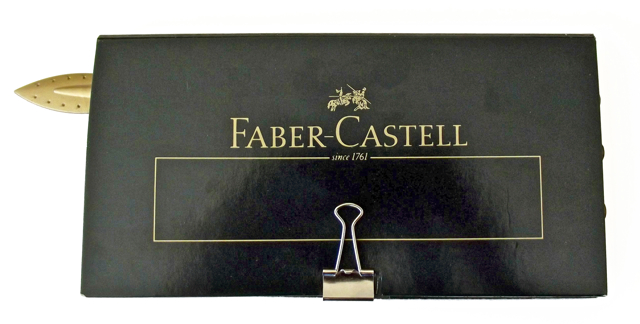
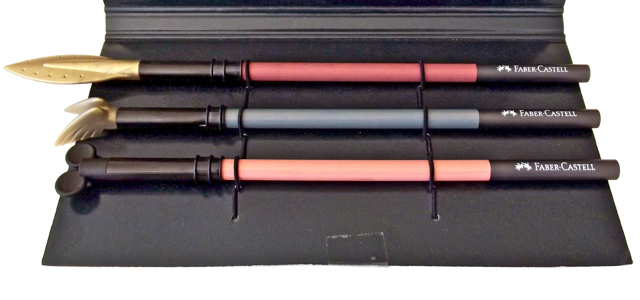
“Have you seen these?” he asked. Smiling and shaking my head as I looked at them, I replied: “No. No I haven’t.” This was just one example of the Count’s generosity, but it was also a subtle demonstration of the encyclopedic command he has over the vast catalog of Faber-Castell products, past and present.
Before I knew it though, the Count had already spent almost an additional hour of his time, and he needed to be on his way.
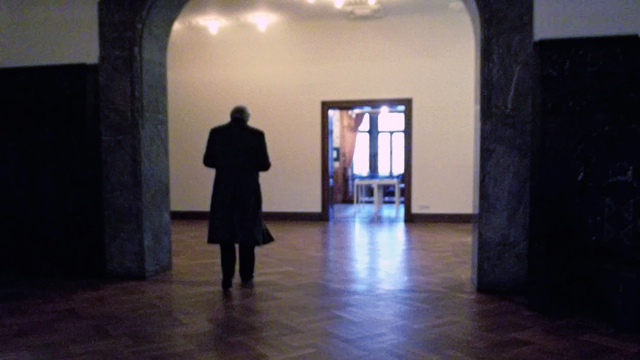
After one last handshake and wishing me a safe journey home, he donned his coat and was off to his next appointment, bringing to a close two extraordinary days.
Epilogue
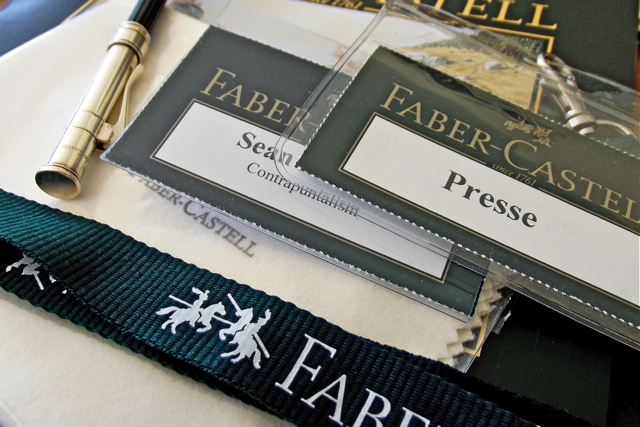
Apart from being immersed in the history of Stein and Faber-Castell, there was something else that I came away with from this visit.
It’s easy to think of Faber-Castell as being a large corporate entity, given its global presence and its longevity. And along with that perception can come a lot of the things one might associate with large corporations too, such as a disconnect with the consumer and cynicism toward tradition, but this is a mistake. Instead, I’ve come to understand that Faber-Castell is essentially an intimate, family-run mittelstand company—but one that just happens to be all over the globe. While that may seem incongruous it helps to explain some other incongruous things, such as the times when it has been difficult to find product information—or even products themselves—in the U.S. And since there isn’t an exact analog to the mittelstand in America, the sense of tradition that comes from being a 250-year-old company (as well as the pride found in the city where it was established), can easily be lost, overlooked, or just misunderstood.
However, it also helps to explain how something as ordinary as the pencil has had such an extraordinary story. And despite already being a bit familiar with that story, this visit to Stein has given me even more reason to pause in fascination and appreciation.
Thanks very much to Sandra Suppa, Antje Röder, Stephanie Birch, and Christiane Regler for their time and attention (and patience), as well as archivists Edith Luther, Correlia Börner, and Emmerich Varga. Last but not least, special thanks to Count Faber-Castell for his generosity of time and spirit.

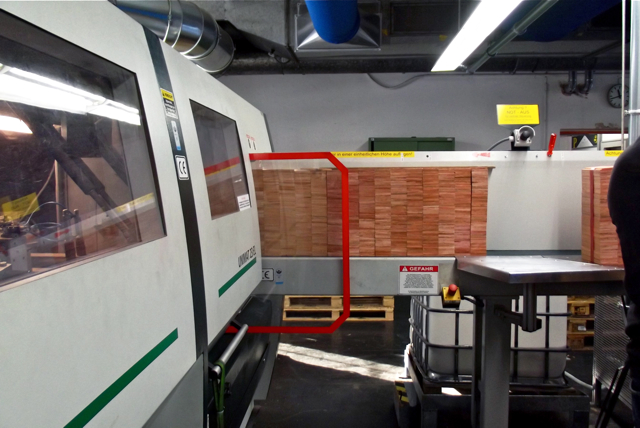
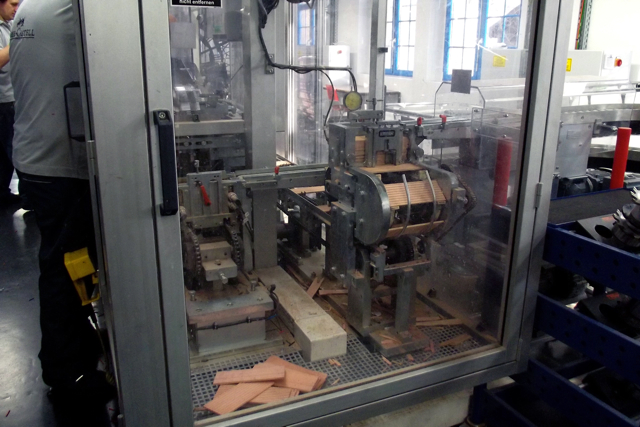


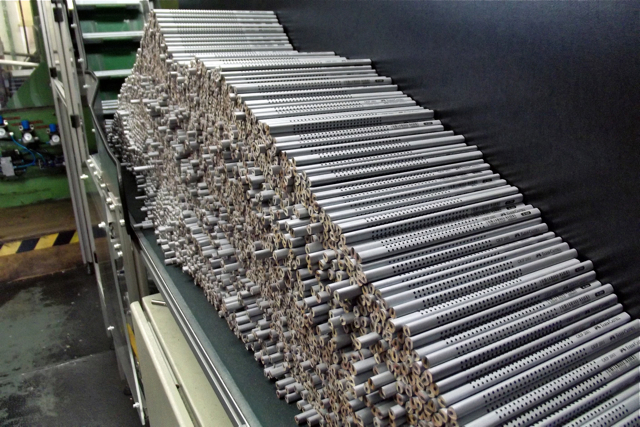


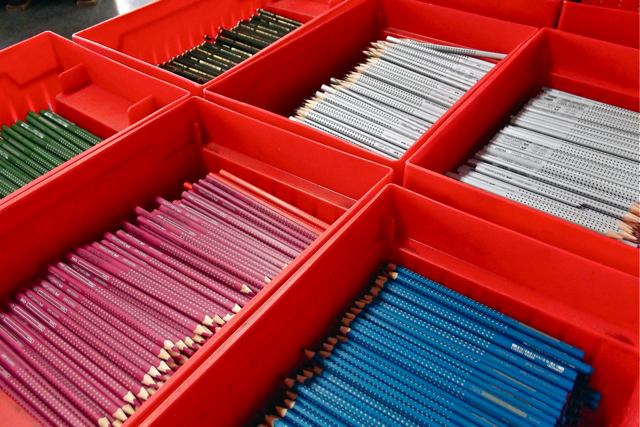
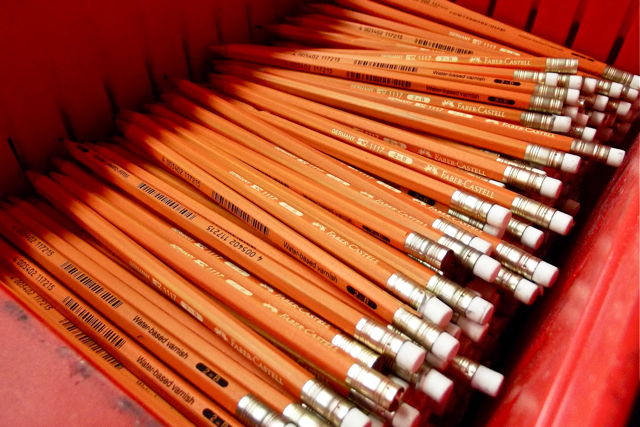

Wow! What a super cool experience. Thank ou for sharing!
LikeLike
This must have been almost surreal! Thanks for all the pictures and description of the interview with the Count himself. Definitely a trip to make.
LikeLike
Thank you for your beautiful account of your visit to Faber-Castell, and time spent with the Count. Your photos are beautiful. I have been using Faber-Castell pencils for drawing all my life, and hope to have a chance to visit this enchanted place in 2014.
LikeLike
Thanks, Ceil. “Enchanted” is a great way to describe it.
LikeLike
Pingback: Wanted Down Under: the Castell 9000 » Bleistift
I remember going through Stein in 2011. There was a roundabout (or turnaround) that had a display of giant Faber-Castell pencils and I’ve been trying to find out where it was. Did you see it?
LikeLike
The only thing I can think of that matches your description was a large metal sculpture of some pencils and a sharpener in the parking lot. Is that it?
LikeLike
Perhaps. From my recollection, each pencil was a different color.
LikeLike
Hi Annette, the roundabout that you speak of can be seen approaching Stein from the direction opposite Nuremberg. Coming from the Nuremberg airport into Stein, one would not see it.
LikeLike
Thanks Marylou. That sounds right as we were travelling from Regensburg to Rothenburg.
LikeLike
I took my two daughters to the Castle in 1989 when we were stationed in Ansbach, not far away. I was with the US Army. They were young but still have memories and the youngest, an artist, recently wrote “I actually think of the Faber-Castell castle every time I see Faber-Castell.” Your visit sounded wonderful!
LikeLike
I am going to see that castle someday!
LikeLike
I very much enjoyed reading your blog on Faber-Castell and I have to tell you, I met the Count in Australia in around 1986?? Can’t quite recall the exact year.
His brother Andreas lived 2 doors down the street from my parents place and my father became great friends with the family.
I even did babysitting duties for Virginia and Andy Faber-Castell for their 3 children when I was at Uni and saving to travel overseas!
The family also vacationed with us in Forster regularly, as we had a large holiday house there.
I have so many photographs and stories from that time – my parents lived in the same street until the Faber-Castell’s sold their house; from around 1988 to 2000?
When I first met the family, I didn’t quite register the name, and really didn’t take much notice – they were very “Australian” if you know what I mean and lived normal lives in the northern suburbs of Sydney. They didn’t really pay much attention to their name and got on with life as most ordinary families.
Andreas had a printing company and his wife Virginia was a Dental Hygienist.
Please feel free to email me if you would like more information.
LikeLike
Pingback: Roteiros e dicas de Nuremberg: o coração da Francônia | Sundaycooks
This sounds just wonderful, what an adventure. Where did you stay in Stein?
LikeLike
Pingback: Frankfurt (1) | Contrapuntalism
Pingback: Catalogs | Contrapuntalism
Pingback: Bands of Brothers | Contrapuntalism
Oh, how I want to go there.
LikeLike
Pingback: The House That Faber Built | Contrapuntalism
Pingback: Two Knights to Remember (II): “A Typical Franconian Meal” | Contrapuntalism
Pingback: Anton-Wolfgang Graf von Faber-Castell | Bleistift
Pingback: Anton-Wolfgang Graf von Faber-Castell, 1941-2016 | Blackwing Pages
Pingback: GvF-C | Contrapuntalism
Pingback: GvF-C | Blackwing Pages
Do you have other insights from the Baron about the popularity of the Blackwing to share in future posts? Must have been an extraordinary experience! Thanks for sharing.
LikeLike
Thank you for sharing all of this. Its fascinating to see someone take such an interest in my family history. One of my earliest memories is of my grandmother, who was a Faber, using her Blackwing pencil to do the New York Times crossword puzzle. Thanks for bringing that all back to me.
LikeLike
Pingback: Befiehl du deine Wege | Contrapuntalism
I am a software engineer by profession. I was using Faber-Castell whiteboard marker and became curious of what is the story behind it. I googled and your blogged popped at top. Reading this was a pleasure and a great 10 minutes shift from the work monotone. Loved it.
LikeLike